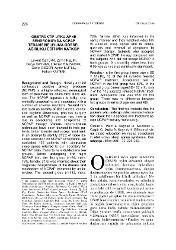| dc.contributor.author | Öztürk, Levent | |
| dc.contributor.author | Pelin, Zerrin | |
| dc.contributor.author | Özgür, Canip | |
| dc.contributor.author | Kaynak, Hakan | |
| dc.date.accessioned | 2020-09-29T11:52:09Z | en_US |
| dc.date.available | 2020-09-29T11:52:09Z | en_US |
| dc.date.issued | 2001 | en_US |
| dc.identifier.issn | 1300-5227 | en_US |
| dc.identifier.uri | https://hdl.handle.net/20.500.12469/3459 | |
| dc.description.abstract | Obstrüktif uyku apne sendromu tedavisinde cerrahi tedavi ile birlikte en sık kullanılan yöntem sürekli pozitif havayolu basıncı (Continuous Positive Airway Pressure: CPAP) ile yapılan tedavidir. CPAP cihazının tedavi seçeneği olarak hasta tarafından kabul edilmesi, gündüz aşırı uyku hali, hastalığın şiddeti, daha önce geçirilmiş cerrahi operasyon gibi birçok farklı nedene bağlıdır. Çalışmamızda, tedavinin kabulünü arttırmak açısından görsel ağırlıklı eğitimin etkileri 196 hasta üzerinde araştırıldı. Hastalar iki gruba ayrılarak bir gruba (n=84) standart muayene ve tetkik yöntemleri uygulandı; diğer gruba ise (n=112), ilk gruptan farklı olarak video film desteği ile birlikte OSAS hastalığı ve sonuçları hakkında görsel ağırlıklı bir eğitim de verildi. Eğitim alan hasta grubunda CPAP tedavisini kabul etme oranının (%93), eğitim almayan hasta grubuna göre (%82) anlamlı derecede yüksek olduğu (p<0,05) gözlendi. | en_US |
| dc.description.abstract | Background and Design: Nasally applied continuous positive airway pressure (NCPAP) is a highly effective, nonsurgical form of treatment for obstructive sleep apnea. The NCPAP apparatus is bulky, cosmetically unappealing and associated with a number of adverse reactions. Several factors such as severity of sleep apnea, excessive daytime sleepiness, previous surgery as well as NCPAP apparatus may have a role in acceptance and compliance of NCPAP therapy. Various desensitization techniques have been devised to help patients better tolerate and accept treatment. In an attempt to identify effect of video assisted education on NCPAP acceptance, we evaluated 196 patients with obstructive sleep apnea referred to our laboratory for NCPAP trials. Patients were divided into two groups. Before undergoing first night NCPAP trial, the first group (n=84, male: 73%, female: 27%) was informed about their diagnosis, complications of the disease and mechanism of NCPAP treatment by an interview. The second group (n=112, male: 72%, female: 28%) was informed in the same manner and they watched video film to visualize sleep apnea and its consequences and reversal of symptoms by NCPAP therapy. Subjects who accepted and started NCPAP therapy compared with the subjects who did not accept NCPAP in both groups. A probability value less than 0,05 was considered statistically significant. Results: In the first group (mean age ± SD = 51±10), 15 of the 84 subjects rejected NCPAP treatment. Acceptance rate of NCPAP in the first group was 82%. In the second group (mean age ± SD= 52 ± 9), only 7 of the 112 subjects refused NCPAP treatment. Acceptance rate was 93% for this group. There was no difference between two groups in terms of age, sex and RDI. Conclusion: The findings indicate that the patients who undergo video assisted education about their diagnosis and treatment accept NCPAP therapy more easily. | en_US |
| dc.language.iso | tur | en_US |
| dc.rights | info:eu-repo/semantics/openAccess | en_US |
| dc.subject | Hasta eğitimi | en_US |
| dc.subject | Araştırma teknikleri | en_US |
| dc.subject | Uyku apne, tıkayıcı | en_US |
| dc.subject | Patient Education | en_US |
| dc.subject | Investigative Techniques | en_US |
| dc.subject | Sleep apnea | en_US |
| dc.title | Obstrüktif uyku apne sendromu'unda NCPAP tedavisine uyuma görsel ağırlıklı eğitimin katkısı | en_US |
| dc.type | other | en_US |
| dc.identifier.startpage | 226 | en_US |
| dc.identifier.endpage | 230 | en_US |
| dc.relation.journal | Cerrahpaşa Tıp Dergisi | en_US |
| dc.identifier.issue | 4 | en_US |
| dc.identifier.volume | 32 | en_US |
| dc.institutionauthor | Öztürk, Levent | en_US |
| dc.relation.publicationcategory | Diğer | en_US |
















